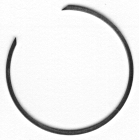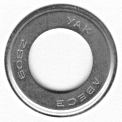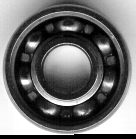The Bearing Maintenance File
(written May 2, 1992)
(last changed Jan 6, 1995)
(updated Apr 56, 2003)
Contents:
General Info
The standard inline skates bearings have the
designation "608". The "608" means that the bearings are
from the 600 series, with a 8mm inner diameter (the width of the hole, i.e.,
internal bore). The "6" appears to be for the 6mm difference between
the inner and outer radii (from the outside edge to the edge of the hole).
608 bearings are also the standard size for skateboard bearings. Quad
skates use either type 608 (8mm internal bore) or type 627 (7mm internal bore).
The 608's for quads are the outdoor bearings. If your bearings have letters
following the "608" (like "S", "Z", or even
"ZZ" or "SS") it is the manufacturer's way of denoting
sealed or perhaps double shielded bearings. An "RS" label means
shielded but that the shields are removeable (i.e., serviceable bearings). To
make sure what they mean you should probably check with the manufacturer, since
it can vary from company to company.
Lately, the inline industry has been using "688" bearings,
which are micro bearings, to use in wheels with microhubs. The rationale behind
this is to get some weight reduction in the wheel and bearings, while still
having fairly low rolling resistance.
A little cross-reference on part numbers for bearings, the 7MM ones are
for quality indoor skates, the 8MM ones are used for in-lines, other indoor
skates and skateboards.
Double Shielded: NTN Fafnir MRC ND SKF HCH YW7MM 627-ZZ 37KDD 37FF 77037 R7-2Z 627Z 600278MM 608-ZZ 38KDD 38FF 77038 R8-2Z Double Sealed (neoprene rubber): NTN Fafnir MRC ND SKF7MM 627-LL 37PP 37ZZ 99037 R7-2RS8MM 608-LL 38PP 38ZZ 99038 R8-2RS
Single shielded/sealed bearings usually delete one of
the doubled prefix/suffix characters. (Thanks go to George for the above
chart).
Bearings for recreational use generally come grease filled. Some
bearings like GMNs are sold either greased or oiled (but usually greased).
Some of the bearing manufacturers are: Black Hole, Boca, Boss, Cyko, DF,
Fafnir, FKD, Get Your Bearings, GMBH, GMN, Grizzly, Hyper, Kryptonics
(Russian), M&A Smith Stealth, NHBB, NMB, Powell Swiss "Bones",
RPM, Sonic, Terminator, Twincam and Yak. (The NMB's are common as a stock ABEC-1
bearing in production skates, but they also make ABEC-5's). There are many
brands of bearings out on the market now, although you should know that some
are just bearings from the same factory, just labeled differently. Some brands
are NMB, Powell Swiss (commonly called Bones bearings), GMN, Fafnirs,
Black-Hole, YAKs, Twin-cam, M&A Smith Stealth, (Super) Sonic, Terminator,
Hyper (Boss & RPM), FKD, NHBB, GMBH, DF, Grizzly.
Sealed or Shielded?
There are basically two types of bearings: shielded vs
sealed. Very likely you will have shielded bearings, which all stock skates
come with (as far as I know). Shields make it hard for dirt and grime to get
in, but they certainly aren't dust or watertight. For superior protection against the
elemnts, you need sealed bearings.
There are three kinds of
shielded bearings: 1) two shields (metal), 2) one metal shield & one
pop-out cap for maintanence, 3) two pop-out caps. If you have types 2 or 3,
you'll have an easier time re-lubing your bearings (see below)
Sealed bearings have a
teflon or rubber lip seal that actually touches the race and come packed with a
fairly heavy grease. These are quite impervious to dust or water. Rollerblade
sells sealed bearings under the name Max Trainers. You may find other brands as
well. The advantage is that they should last a long time without any
maintenance at all. The trade-off is that these bearings generally cost more
and you also encounter a much higher rolling resistance. Slower bearings are
not necessarily bad, since many people like the added resistance for a better
workout.
Bearing Ratings
Bearings
are rated on the ABEC ("Annular Bearing Engineering Council", annular
means circular) scale. The higher the ABEC number, the greater the manufactured
bearing precision. There are no required materials to meet the ABEC
specifications. The bearings simply have to be made to a certain precision.
You may find cheaper skates
with bearings not even rated on the ABEC scale (primarily on "toy"
in-lines and real low-end/kids skates). These will often be labeled as
semi-precision bearings.
In non-skating applications
(like in industrial machinery) using higher ABEC-rated bearings lets machines
meet particular mechanical tolerance or vibration levels, so they can operate
at a high speed. This is not because there is less rolling resistance, but
rather because the precision is better.
Whether ABEC-5 bearings
will let you skate faster than ABEC-1 bearings is still largely debatable. The
higher precision may not make a significant difference when you're at 10-20mph.
Compare that with typical machinery that may run at 10,000 rpm (~80 mph), where
the smallest change in precision can make a difference. Also, the higher
precision will eventually deteriorate down to ABEC-3 or 1 due to dust, dirt and
regular wear and tear. Cutting down wind-resistance and improving your
technique is probably much more effective at increasing your skating speed.
However, all this is not to
say that there is no reason to buy ABEC-3 or ABEC-5 bearings. Most ABEC-3 and 5
rated bearings are serviceable, while ABEC-1's typically are not. So although
you may not be buying more speed, you will be getting more convenience in
maintanence.
(see related article ABEC = HYPE?)
When to Clean and
Re-lubricate Your Bearings
Exposure to
dirt and water are the main reason that your bearings slow down. Bad bearings
will be ones which don't let your wheels spin for a respectable amount of time
(the definition of "respectable" depends on on your type of
bearings). If you hear or feel the vibrations of metal rubbing on metal,
chances are your bearings are in need of some maintenance.
If some of the balls or
bearing surfaces have become roughened, there's basically nothing you can do.
They won't get any better, but they may last a long time anyway. You can always
replace your bearings a few at a time.
Take care of your bearings
by cleaning and preping them as needed. Assuming normal usage, they should last
through several sets of wheels, depending on how much skating you do.
Replacing Your Bearings
You
probably want to replace some of your bearings if (1) any of them them have
somehow stopped spinning well, despite all the cleaning you do or (2) you want
to change to different types of bearings (racing or sealed or whatever).
How to Take Care of Your Bearings
1st Method: Taking the shields off
- Remove your wheels from the
skates, and push the bearings out with a spare bushing (the plastic/metal
part that goes between the bearings) or one of the several types of
bearing tools available on the market.
- Now there's three types of situations you'll be
in: a) If you have shielded bearings with pop-out caps (Powell Swiss or
Black Hole brands), simply pry/pop out the plastic cap on each bearing.
b)
If you have other serviceable bearings like Twin-cams or YAKs you need to pop
out the snap rings (C-rings) before you take off the shields (use a small
screwdriver to snap out the snap rings).
Shown
below are a close-up of the C-ring and shield when you take them out. Notice
that the C-ring has a diagonal edge at either end. There's really only one end
that you can pry the ring out with (i.e., the end with the pointed edge towards
the inside). In the picture, it would be the end at the top of the image.
(Click on either image to see an enlarged version).


c)
For non-serviceable bearings like NMBs, GMNs (Germans), or sealed bearings, FIRST make this decision: do you want
to take the shields off?
Some
people tell you to never pry off a shield/seal, some say it's okay. It's really
up to you. In general, if you think you will be doing a lot of maintainence on
your bearings, you are much better off taking the shields off. Whatever you do,
the new lubrication always helps.
NOTE: if
you have sealed bearings you might not want to pop the covers since you could
ruin the seal integrity a little, which is what you're paying extra for in the
first place. Still, I have some people say they put their bearings back together
with no harm, so it is possible. For more nitty-gritty on maintaining sealed
bearings, look at http://www.svi.org/~nates/bearing.html.
If
you decide no then skip down to the section marked 2nd
Method.
If
you decide yes then carefully puncture or pry off the shield (or seal)
on one side. Use a very small screwdriver, and pry along the edge of the shield
until you can get under it and pop it off. If this is difficult, you can always
push the screwdriver into the shield (or tap it through (lightly!) with a
hammer or heavier tool). You don't need a whole lot of force since the shields
aren't all that thick or hard.
When
removing the covers of entire sets of bearings at once, be careful to only take
off one cover per bearing. Otherwise you'll be left with a shieldless/sealless
bearing (which won't last long against outdoor conditions).
Once
you have the cover off, you should be able to see the ball bearings inside,
held in place by a retainer (click on the image for a close-up).

You won't need the old metal covers anymore so you can throw them away
(assuming you're using non-serviceable bearings). They're no good anymore
anyway since they're probably bent and warped from the removal.
In
Bones bearings the cap is ALSO the brace, so you won't see a brace, but just 7
bearings rolling around. Bones users should obviously keep the plastic cap when
reassembling their bearings.
NOTE:
You don't want to take the ball bearings out since they aren't meant to be
removed and replaced. Besides, you'll scuff the bearings and they won't roll
well anymore.
- Soak the bearings (c-rings and shields too if
you've got serviceable bearings) in Simple Green or some other
biodegradeable detergent. DON'T dilute with water! Use it straight from
the bottle. The detergents are very cheap and you don't need a whole lot
anyway (just enough to cover the bearings). If you want to speed things up
a little, put your cleaning container in a larger container. Fill the area
around the cleaning container with warm or hot water but not enough to
spill over into the cleaning container.
The
choice of cleaner/solvent isn't crucial so long as you can get all the dirt and
old grease cleaned out. However, I'd highly suggest using one of the
biodegradeable cleaners. They're cheaper, safer, easy to dispose of (just let
it go down the sink) and good for other cleanup tasks as well.
If
you do insist on using solvents, avoid low-flash point solvents like gasoline,
xylene, lacquer thinner, etc. which are dangerously flammable. Also wear
latex/chem lab gloves if possible when handling these chemicals. Solvents are
no fun to ingest or absorb through your skin. An alternative is to use a pair
of tongs or tweezers to handle your bearings.
Soaking the bearings
How
long you soak depends on how dirty and dried out your bearings have gotten.
Previously maintained bearings won't need to soak very long. Bearings that have
gone dry and have lots of grit in them may need to soak overnight, or even
several days.
If
necessary use a brush or swirl your bearings around in your container to make
sure everything breaks loose. Small coffee cans, peanut jars, or even those
little black film canisters, all make decent containers. Dave Woodall
(woodall@adrs1.dseg.ti.com) has his own way of swirling. He uses a battery
operated drink mixer and spins his bearings to cleanliness. He says it works
really fast, so if you like, try it out 8-)
You
don't really need large amounts of cleaner or solvent. Just enough to immerse
your bearings. You also don't need to refill with clean solvent with each
bearing unless the solvent you were using has gotten really dirty. The
essential thing is that the dirt and grease is broken up. Step 4 will remove
most of the gunk.
WD-40
is generally not recommended as a cleaner since it leaves a sticky, dust
attracting film on the bearings. Note, however, that some people swear by
WD-40. It has become somewhat of a heavily-debated topic, so experiment with it
if you'd like.
Ultrasonic
cleaners are ideal for cleaning bearings. If you have access to one, you can
clean your bearings en mass and avoid getting your hands dirty.
- Now
rinse out your bearings with hot, soapy water to make sure you clear out
all the solvent. You now have some clean bearings. If they're truly clean
they ought to spin real fast.
- Use a
hair dryer to make sure that all traces of water are gone.
- Now
lubricate with your favorite lubricant. Lubricant choice always seem to be
somewhat preferential. Lots of people find one lube that works for them
and they just stick with it. It's hard to try out multiple lubricants and
get a thoroughly accurate comparison throughout all types of skating
conditions. 1) people don't always have the extra money to do so, 2) to
change lubes you need to clean and relube (unless you have an extra set of
bearings) and 3) there's still no real good way to measure how well a lube
helps speed up or slow down your skating. A no-load
"finger-flick" spin test doesn't really cut it since it doesn't
entirely translate into the equivalent rolling resistance with your weight
on it.
Ideally, you'd have an indoor
incline and/or flat surface, multiple sets of identical bearings for each lube,
and you'd see which one gave you the most glide. Of course, this still doesn't
take into account how fast the lube dries or bleeds from the bearings, or how
easily it collects or repels dust/grime/water, and on and on.
In the end, it doesn't make a huge
difference unless you're into serious racing. Your main choice will be choosing
between oil, cream/grease, telfon based lubes, (bicycle) wax/paraffin, and
whatever else is out there. Most people end up using grease or oil. Oiled
bearings have slightly less resistance, but need to be maintained more often
(as often as once a week). It is very helpful to have a little hypodermic style
oiler with a long needle to let you put the oil right where you want it.
Grease works well because after a
while most of it gets shoved out of contact with the balls and only a little
bit smears onto the workings. However, newly greased bearings, will take a
while to expel any extra grease and move the rest out of the way.
For oils, although you can use stuff
like sewing machine oil, or 5W-20 motor oil, household oils (3-in-one, etc) may
gum up after a while. In any case, most mail-order shops sell their own brand
of lubricant, as do many of the bearing manufacturers (e.g., Bones and
BlackHole). Although it's not proven these "special" formulas are all
that better, it's usually only a few bucks for a nice little bottle of lube
that should last you for a long time. Some brands also come in a very handy
hypodermic-style dispenser which is perfect for putting a drop exactly where
you want it.
NOTE: Use only a few drops of oil
per bearing! Overlubing will not only waste your lube, but you'll also make the
bearings more sticky and more prone to attracting dust and grime, which is
exactly what you don't want. Spin the bearing to spread the oil around inside.
Let the bearings sit for an hour,
and wipe them off.
- Put one
bearing back into the wheel, with the open face towards the inside of the
wheel. Insert the bushing and then put on the second bearing (with the
open face towards the inside again). It is pretty hard for contaminants to
get into the bearings from the inside.
2nd Method: Keeping the shields on
First do Step 1 (from 1st Method).
If your bearings are permanently sealed (or you don't want to remove the
seals) you can still soak in solvent (see step 3) for several hours or as long
as you feel necessary. Enough solvent should soak through to remove some of the
grease.
Then you can lubricate the seams and/or press some in with your fingers.
Enough oil should seep through to lubricate your bearings (see step 6).
3rd
Method (The Bont Method)
From Bont's web site:
Secret Lubrication Technique:
Wash the bearings in petrol and two stroke oil at approximately 50:1
ratio. Take the bearings out and shake dry. Place them on a clean dry cloth or
paper towel. When all the petrol has evaporated, reinstall the bearings without
adding any further lubrication. Your baby bonts will go even faster! This
should be repeated every few days to a week or when they start to feel dry.
This technique can be used on all bearings. This works far better than all the
speed lubes you spend your $ on.
*All images copyrighted © 1992-2003 by Anthony D.
Chen. Permission is granted to use this logo in World Wide Web HTML files so
long as this copyright notice is included as either an HTML comment alongside
the invokation (IMG SRC or HREF or otherwise) of the logo, or in the visible
text.
The image may not be sold for profit, nor incorporated in commercial
documents or merchandise without prior written permission of the copyright
holder.